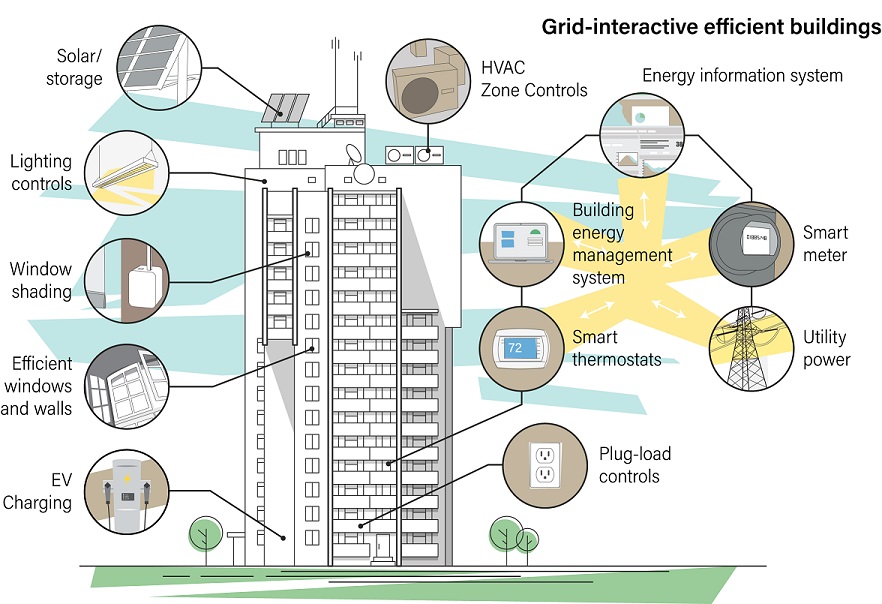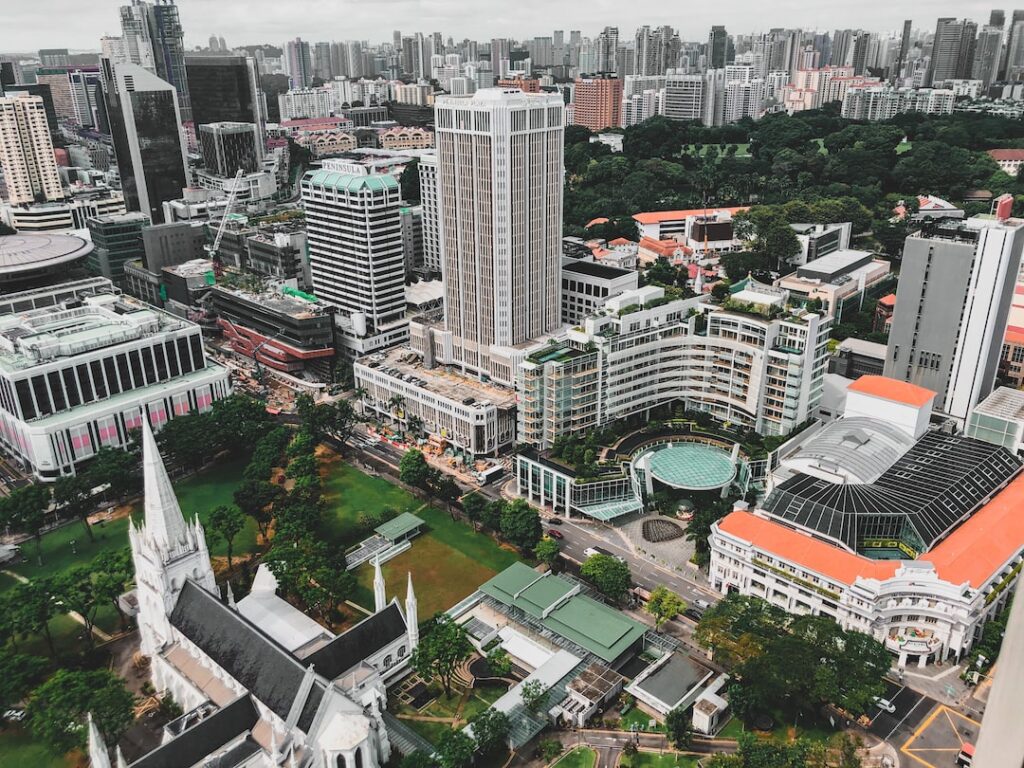Energy efficiency in commercial spaces is an important step toward a more sustainable future. But how to achieve energy efficiency in buildings?
By improving the insulation, lighting, and HVAC systems and implementing renewable energy sources, we can make our businesses significantly more efficient when consuming electricity. This not only reduces costs for building owners but also has a positive environmental impact by reducing carbon emissions.
Let’s explore how each element contributes to how to achieve energy efficiency in buildings.
Table of Contents
How to Achieve Energy Efficiency in Buildings
Let’s start with building insulation. There are several types of insulation available for use in buildings. The most common type is fiberglass which is made from recycled glass and comes in rolls or batts that can be cut to fit the space.
Cellulose is another type of insulation that is made from recycled paper products.
Rock wool is made from volcanic rocks and foam board insulation consists of rigid panels that can be used to insulate walls and floors.
Each type of insulation has its own benefits and drawbacks so it’s important to research each option before making a decision.
There are many benefits to installing insulation in a commercial building.
- Improved energy efficiency.
- Reduced indoor noise levels.
- Better indoor temperature control throughout the year.
- Increased comfort levels inside the office space.
- Lower utility bills due to reduced energy consumption.
- Improved air quality with minimal airborne pollutants like dust mites and mold spores.
Additionally, installing insulation may also qualify businesses for tax credits or other incentives depending on their location.
How much does it cost to install building insulation?
The cost of installing building insulation will vary depending on factors such as the size of the area and the type of material.
Generally speaking, costs range anywhere between $0.50 and $2 per square foot for materials alone. It is important to note that while upfront costs may seem high at first glance, there are long-term savings associated with proper insulation installation so it is worth doing your research beforehand when considering this project.
Now let’s look at lighting solutions that can contribute to how to achieve energy efficiency in buildings.
Energy-Efficient Lighting
If you’re looking for energy-efficient lighting options for your facility, then LED lighting is the best choice. LED lights consume less power than traditional incandescent bulbs, and they last much longer too!
LEDs also produce less heat than other types of light sources, which can help reduce cooling costs in the summer months.
LED bulbs come in a variety of colors and styles to fit any decor or application, making them an ideal choice for any type of commercial building.
The cost of LED lighting varies depending on the type and size you choose. However, it typically ranges from $10 to $100 per fixture with installation included.
Natural lighting is another way to save on energy costs while providing beautiful illumination throughout your facility.
Skylights, windows, and solar tubes are all great options for bringing natural light into your building without relying on electricity-powered fixtures. Not only do these solutions provide free illumination during the day, but they also bring in warmth from the sun that can help reduce heating bills during winter months.
Natural lighting solutions such as skylights tend to be more expensive upfront due to installation costs. However, they will pay off over time by reducing energy consumption significantly compared to traditional electric fixtures.
Lighting is an important part of how to achieve energy efficiency in buildings. By utilizing LED lighting solutions or natural lighting, building managers can ensure that every department is as energy-efficient as possible.
Up next: HVAC systems.
Energy-Efficient HVAC Systems
HVAC systems are an important part of any facility as they provide comfort to building occupants through cooling in the summer and heating in the winter.
There are a variety of HVAC systems available, each with its own benefits and costs associated with installation.
The most common type of HVAC system is the split-system air conditioner which consists of two parts – an outdoor unit that houses the compressor and condenser coils, and an indoor unit that contains the evaporator coil.
There are also heat pumps, ductless mini-splits, furnaces, boilers, and geothermal systems for heating and cooling a building. Each type has its own advantages in terms of energy efficiency and cost savings.
Installing a properly sized HVAC system can help reduce energy bills by up to 30%. It can also improve air quality by removing allergens from the air while also helping to maintain comfortable temperatures indoors all year round.
A good HVAC system can extend the lifespan of appliances such as refrigerators or freezers as they won’t have to work as hard when temperatures are regulated inside a building.
Ultimately, it is best to get several quotes from different companies before making a decision so you know what kind of deal you are getting.
HVAC systems are a great way to increase energy efficiency in buildings, but there are other options available. Renewable energy sources such as solar and wind power can also be used to reduce the building’s carbon footprint and provide clean, sustainable electricity.
 (Source)
(Source)
Renewable Energy Sources
Solar power is a renewable energy source that can be used to generate electricity. It works by capturing the sun’s energy and converting it into usable electricity.
Solar panels are made of photovoltaic cells which absorb sunlight and convert it into direct current (DC) electricity. This DC electricity is then converted into alternating current (AC) electricity through an inverter, which can then be used to power buildings.
Wind power is another form of renewable energy that harnesses the kinetic energy from wind turbines to generate electrical power.
Wind turbines use blades to capture the wind’s kinetic energy and convert it into mechanical energy, which is then converted into electrical power using a generator connected to the turbine shaft.
Optimize Your Building With Smart Technology
Smart technology is an effective way to optimize energy usage in your buildings.
With low-cost, easy-to-install sensors and controls, you can measure and monitor energy consumption in real-time. This will enable you to identify trends quickly without having to examine utility bills or other sources of data.
You can also reduce labor hours by implementing HVAC systems that automatically adjust temperatures based on occupancy levels or lighting solutions that turn off when not needed.
By optimizing light sources with motion sensors and dimmers, you’ll be able to save money while still providing adequate illumination for safety purposes.
Additionally, automated systems like these require less maintenance than manual ones so they are more cost-effective over time.
In addition to reducing costs associated with labor hours and resources, smart technology helps create a healthier environment by improving air quality through better ventilation control and reducing noise pollution from outdated machinery. It also increases comfort levels by creating personalized temperature settings for each room in the building based on user preferences rather than one universal setting for the entire facility.
Overall, utilizing smart technology is a great way to maximize the energy efficiency of your buildings. Not only does it help reduce operational costs but it also improves indoor comfort levels which leads to increased productivity among employees and tenants alike.
Conclusion
Learning how to achieve energy efficiency in buildings is an important step towards reducing our carbon footprint and helping to protect the environment. By making use of proper insulation, efficient lighting and HVAC systems, smart technology, and renewable energy sources, we can make a big difference in how much energy our buildings consume.
We must take action to make buildings more energy efficient. By implementing green building practices, we can reduce our environmental impact while also saving money on utility bills. Let’s work together to create a greener future for generations to come!
The cost of installing building insulation will vary depending on factors such as the size of the area and the type of material.
Generally speaking, costs range anywhere between $0.50 and $2 per square foot for materials alone. It is important to note that while upfront costs may seem high at first glance, there are long-term savings associated with proper insulation installation so it is worth doing your research beforehand when considering this project.
Now let’s look at lighting solutions that can contribute to how to achieve energy efficiency in buildings.
Key Takeaway: Insulation is an important part of achieving energy efficiency in buildings. It helps to reduce the cost of heating and cooling and provides soundproofing benefits as well.
Key Takeaway: Insulation is an important part of achieving energy efficiency in buildings. It helps to reduce the cost of heating and cooling and provides soundproofing benefits as well.
Key Takeaway: Insulation is an important part of achieving energy efficiency in buildings. It helps to reduce the cost of heating and cooling and provides soundproofing benefits as well.





